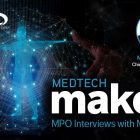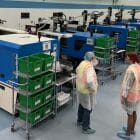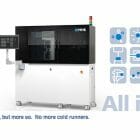NPI/Medical has almost a decade plus experience in processing medical grade silicones for a variety of applications including healthcare and optical LSR (Liquid Silicone Rubber) Additionally, Tim Erwin our Sr. Technical Advisor is an LSR guru with 30+ years of experience processing silicones. Our proprietary silicone master frame and two state-of-the-art vertical and horizontal 55ton Arburg machines enables in-house processing from prototype through production to accelerate your speed-to-market.
Why should you consider using a silicone material in your next medical device?
1. Overall design flexibility
Molding with optical grade silicone exhibits the many benefits associated with molding silicone rubber, but offer the added benefit of optical clarity needed for specific applications. Particularly in the medical device market, functionality is absolutely crucial, and with applications that are based around highly precise features, factors such as viscosity and molding parameters can make or break an entire program. The flexibility of optical grade silicone allows for designs with undercuts, negative draft angles, and fine features, and the assembly can be simplified by adding gasketing, sealing, and mounting features directly onto the part without compromising optical characteristics.
2. Ability to mold complex geometries
Most applications using optical grade silicone center on highly precise geometries that are almost impossible to fabricate with current materials and methods, and the low viscosity before cure makes molding optical grade silicone into complex shapes easier than with either glass or organic polymers. The most common application that optically clear silicone is being used for currently is to offer alternatives to polycarbonate, glass, or polymethyl methacrylate (PMMA) in situations where traditional materials are limiting the design or function of the device. Because of the low viscosity of the material, liquid injection molding of optical grade silicone allows for the molding of geometries that would not otherwise be possible with other polymers and glass. More precise features, varying wall thickness, reduced likelihood of sink allowing for thicker walls, small undercuts, negative draft, and difficult parts to fill are all possible with this material, allowing designers to really test their product’s limits.
3. Physical benefits during molding
OEMs and molders have been heading in the optical grade silicone direction because of the physical benefits silicone offers, including bacterial resistance, UV resistance, biocompatibility, low viscosity for molding precise and difficult features, temperature flexibility from -180F to 600F, chemical resistance, and fatigue and compression set resistance. It is also significantly lighter than most plastics and glass, and silicones in general are lighter in weight than traditional optical materials. Because the material is a thermoset, it does not have molded-in stresses like thermoplastic resins do.
4. Cosmetic benefits
Beyond the design and manufacturing benefits, there is a push towards optical grade silicones purely for cosmetic purposes. In the medical device world, quality is held above all else, and anything that appears to be flawed or dirty can be interpreted as a defect. Even if it has no effect on the function of the device, a yellowing or discolored part will be misinterpreted by doctors and patients. Regardless of how old it is or where it has been, optical grade silicone does not lose transparency or discolor with age, or with exposure to UV light, moisture, or heat. It requires no polishing after molding and is resistant to scratches, cracks, and breaks. Optical grade silicone is essentially unaffected by environmental factors and remains attractive throughout the life of the device, never worrying a doctor or patient if something is unsafe.
5. Overall reduction of costs
Due to the elastomeric nature of this material, it can reduce the need for additional parts and secondary operations, lowering tooling and non-recurring engineering (NRE) costs. For example, in a traditional lighting application where optical silicone is not being used, a lens and a seal would be two separate parts. By molding the lens with an optical grade silicone, the seal can be incorporated into the lens, ultimately eliminating an entirely different part and assembly step. This decreasing of the manufacturing process reduces inventory, bill of materials, time-to-market, and overall project cost significantly.
Using optical grade silicone in the healthcare industry is an exciting, albeit challenging opportunity for molders and OEMs. The design options with this material are endless, and due to the flexible nature of optically clear silicone, there is unlimited potential for new innovations and devices. We are starting to see a new wave of product development, silicone tooling, and DFM work being introduced to the marketplace with no intention of slowing down.
5 Types of Silicones and their associated properties
1. Silanes and coatings are single component products that can be used to promote adhesion to substrates, crosslink plastic polymers to improve their performance properties, scavenge water to prevent premature curing of compounds and improve stability, and as a coupling agent to bind organic polymers to mineral or siliceous fillers for improved bonding and strength
2. Silicone fluids are commonly used in high performance lubricating applications involving extreme high or low temperatures. They can also be used as an additive to enhance the performance of greases, pastes, and other lubricants.
3. Silicone sealants come in one- or two-component forms. The two-component form requires the end user to measure and mix the two parts together just prior to using and can be a bit tricky to use. The more common one-component form starts to cure as soon as it is exposed to air (actually the moisture in the air) and must be applied fairly quickly. These are commonly used as automotive sealants or gaskets, moisture barriers for kitchen or bathroom fixtures, and for sealing windows and doors
4. Silicone elastomers (LIM or LSR) are castable or moldable thermoset polymers with a broad range of characteristics and end uses. They are two-component resins (commonly called “A” and “B” component) that are stable for long periods of time when kept separate and sealed. They too begin to catalyze (set or harden) when mixed, but can have extended pot lives (time they can be applied, formed, or used) of up to several days at room temperatures—even longer if kept cool or cold—but set quickly at elevated temperatures (seconds at 150-180ºC). They exhibit an extended range of qualities, characteristics, and appearance, and are used for an array of products from baby bottle nipples, oven bakeware non-stick liners, healthcare or medical products, valves, and high friction grips on tools and appliances.
5. R.T.V. (room-temperature vulcanizing) are two-component silicones that, when mixed together, begin to catalyze but have a reasonable pot life to enable them to be cast or poured to form a variety of end-use products. They are used in the mold-making industry to make rapid tooling for prototype parts, electronics industry for potting or encapsulating components for environmental protection of sensitive components, and movie/entertainment industries to make life-like characters or for special effects.















